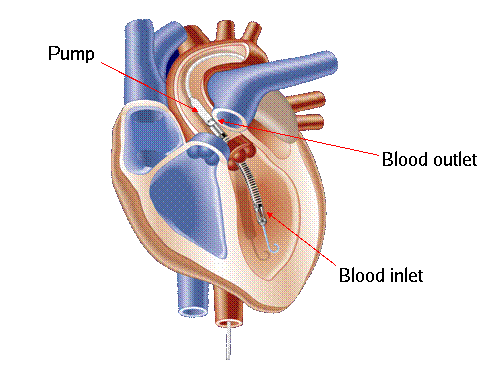
Study Group Mathematics with Industry 2007
Universiteit Utrecht, 29 January - 2 February 2007
[ KLM ]
[ Innogrow ]
[ ASML ]
[ ING ]
[ UMC ]
[ AMC ]
Case 6
Optimizing the function of artificial heart pumps in humans

In acute heart failure, the cardiologist or cardio-thoracic surgeon may introduce a catheter-mounted pump into the left heart chamber. The left heart chamber is responsible for maintaining the circulation through the following organs: brains, muscles, intestines, kidneys etc. Therefore, acute heart failure, and specifically heart failure of the left chamber, results in so-called cardiogenic shock and finally multi-organ failure. To avoid this lethal chain of events and to enhance the potentials of recovery, it is mandatory that the circulation be maintained at a level of 4 to 5 litres per minute. The catheter-mounted heart pump has, depending on the size of the catheter, a capability of pumping 2.5 to 5 litres. The catheter is introduced through a peripheral artery into the shoulder or groin, and then introduced into the left heart chamber. It, indeed, is the so-called Impella, which pumps the blood from the chamber through the device into the ascending aorta. The aortic valve is closed and prevents back flow and regurgitation of the displaced volume.

Figure: Impella implanted in the heart
The pump has been designed for the following applications:
- First of all, maintenance of adequate circulation by providing a laminar flow of 5 litres per minute.
- Second, by retrieving blood from the left heart chamber, unloading of the heart occurs and reduction of wall stress is achieved. This so-called unloading enables the heart to recover from either an infarction or a disease of the heart muscle. For the simplicity of the case, it is most effective to focus on the 5-litre pump.
The problems are the following:
Wall stress remains under 20 kilo Pascal, as this is the threshold for irreversible distension and disruption of the acting myosin bridges in the cardiac myosin.
Is it possible, based on preload and afterload and knowledge of the systolic/diastolic volume of the left heart chamber (which may be presented as an ellipse-shaped chamber with an inlet and an outlet valve) to calculate the wall stress?
Is it possible, given the fact that echocardiography provides a short-axis and a long-axis cross section of the ellipse-shaped chamber, to give a more precise calculation of the wall stress, based on such near-three dimensional representation?
Given the fact that in case of heart failure the differences between systolic and diastolic motion are decreased and the fact that based on distension of this chamber a sufficient amount of blood is present in the chamber and given the fact that there is an inlet and an outlet valve, which function appropriately, is it possible to calculate the true capacity of the pump? In other words: is the specified displacement of volume determined by the rotations per minute and is it for instance fixed at a maximum of 5 litres? However, do the actual displacement of fluid and the velocity of the flow depend on pressures at the inlet in the actual pump chamber and pressures in the so-called outlet compartment? In other words: do the actual unloading and displacement of flow depend on pre- and afterload?
Is it possible to describe the effectiveness of the pump in terms of rotations per minute and in terms of unloading, meaning that sufficient circulation is maintained and adequate reduction of wall stress is achieved? This description should be based on pre- and afterload pressures, the volume of the chamber, and the capacity of the pump.



